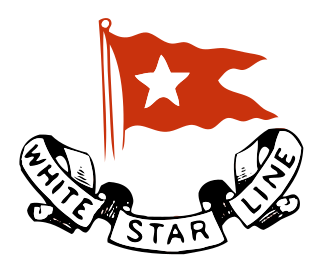
The White Star Line was a British shipping line. Founded out of the remains of a defunct packet company, it gradually rose up to become one of the most prominent shipping companies in the world, providing passenger and cargo services between the British Empire and the United States. While many other shipping lines focused primarily on speed, White Star branded their services by focusing more on providing comfortable passages for both upper class travellers and immigrants.

RMS Celtic was an ocean liner owned by the White Star Line. The first ship larger than SS Great Eastern by gross register tonnage, Celtic was the first of a quartet of ships over 20,000 tons, the dubbed The Big Four. She was the last ship ordered by Thomas Henry Ismay before his death in 1899. The second liner of her name she was put into service in 1901. Her large size and her low but economical speed inaugurated a new company policy aiming to favour size, luxury and comfort, to the detriment of speed.
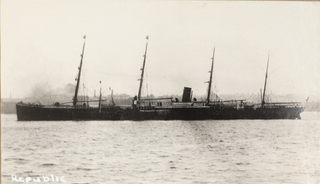
SS Republic was an ocean liner built in 1871 by Harland and Wolff for White Star Line. It was intended to be the last of four vessels forming the Oceanic-class, before two new ships were commissioned. After a rough maiden voyage from Liverpool to New York City on 1 February 1872, the ship was chosen to be on White Star Line's first voyage on the South Atlantic and Pacific line with four other ships, destined for Chile. In 1874, the construction of modern ships SS Germanic and SS Britannic led to SS Republic's becoming the standby vessel of White Star Line. It occupied this position for 15 years, and attempts were made to modernise it in 1888. When RMS Teutonic and RMS Majestic entered service in the following year, the Republic became surplus to White Star's needs.

SS Ionic was a steam-powered ocean liner built in 1902 by Harland and Wolff in Belfast for the White Star Line. She was the second White Star Liner to be named Ionic and served on the United Kingdom – New Zealand route. Her sister ships were SS Athenic and SS Corinthic.
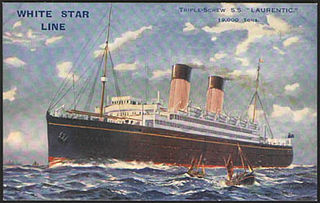
The second SS Laurentic was a 18,724 GRT steam ocean liner built in 1927 by Harland and Wolff, Belfast, for White Star Line. She was the last steamship to be built for White Star Line.

The Athenic-class ocean liners were a three ship class of ocean liners built by the Harland & Wolff shipyard for the White Star Line in the early 20th century.

SS Doric was a British ocean liner operated by White Star Line. She was put into service in 1923. She was the second ship of the company to bear this name. Built by Harland and Wolff in Belfast, she was the company's second and last ship to be exclusively powered by turbines, after SS Vedic.

SS Zealandic was a British ocean liner initially operated by White Star Line. She was used both as a passenger liner and a cargo ship as well as serving during both world wars.

SS Corinthic was a British passenger ship, built in 1902 by Harland & Wolff and launched for the British shipping companies White Star Line and Shaw, Savill & Albion Line. She was the second of the Athenic-class ocean liners built for passenger and cargo service between Britain and New Zealand. Her sister ships were SS Athenic (1902) and SS Ionic (1903).

SS Belgic was a steamship of the White Star Line. The first of the company's four ships bearing this name, she was first assigned, with her sister ship, the Gaelic on the route to France and South America, where the company has recently tried to establish itself. The experience was short-lived, however, and at the end of the year, the Belgic was the last White Star Line steamer to serve on this route. She was then moved to the North Atlantic route.

SS Delphic was an ocean liner of the White Star Line, built by Harland and Wolff in Belfast and completed on 15 May 1897. She worked the New Zealand trade. She was a fairly slow ship primarily intended for transporting emigrants and goods to New Zealand. Despite this, she made her first crossings on the New York route before joining the route to New Zealand. For twenty years, her service on this route was uneventful, with the exception of troop transport missions during the Second Boer War.

SS Coptic was a steamship built in 1881, which was successively owned by the Oceanic Steam Navigation Company, the Pacific Mail Steamship Company, and the Japanese Oriental Steam Ship Co. before being scrapped in 1926. She was filmed by Thomas Edison in 1897 in one of his early movies. The movie is currently stored in the Library of Congress, archive.org and other internet archives.

SS Gaelic was a steamship of the White Star Line, built by shipbuilders Harland and Wolff of Belfast.

SS Ionic was a cargo liner initially in service with White Star Line from 1883 until 1900. She was used on the company's joint route to New Zealand with the Shaw, Savill & Albion Line. She was sold to the Aberdeen Line in 1900 and renamed SS Sophocles, and was withdrawn for service in 1906 and scrapped in 1908.
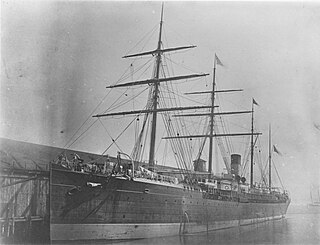
SS Arabic was a steamship of the White Star Line and its first steel-hulled vessel. Like her predecessors, she was built by shipbuilders Harland and Wolff of Belfast.

The Occidental and Oriental Steamship Company was an American shipping company founded in 1874 by US railroads wishing to provide competition to the Pacific Mail Steamship Company which had not complied with its obligations to them. Chartering vessels from different companies, the most important being the British White Star Line, the company quickly became financially successful, against the expectations of its founders.

The Oceanic class were a group of six ocean liners built by Harland and Wolff at Belfast, for the White Star Line, for the transatlantic service. They were the company's first generation of steamships to serve the North Atlantic passenger trade, entering service between 1871 and 1872.

The Delphic was a British freighter operated by the White Star Line, the company's second ship to bear this name. She was built by the Harland & Wolff shipyards in 1916 to serve the war effort under the name of War Icarus, belonging to the series of "Type G" cargo ships. Launched in September 1918 and commissioned in the following October, she was the only ship in the series to be completed before the end of the First World War. During this time, she was operated by a Liverpool company.
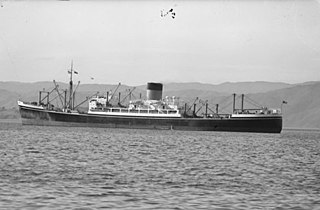
SS Runic was a refrigerated cargo ship built at Harland and Wolff, Belfast in 1949 for the Shaw, Savill & Albion Line. She was launched at Belfast in October 1949, and entered service in March 1950, and was designed for trade between the United Kingdom, Australia and New Zealand. She had two sister ships; Persic and Suevic.




















